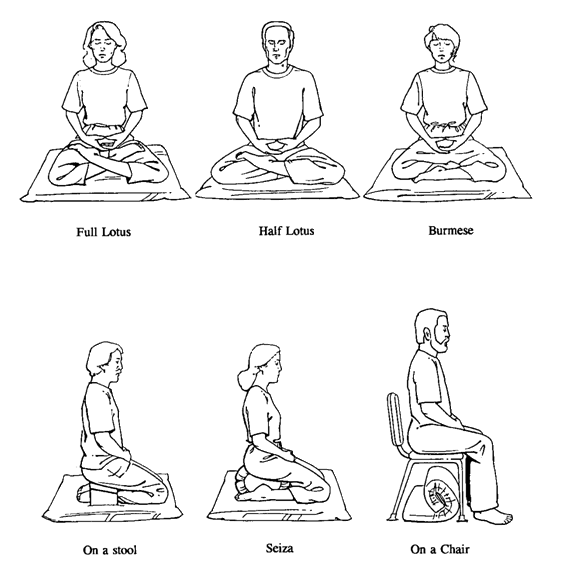A meditation posture should include three main qualities:ALIGNMENT, RELAXATION
and STILLNESS

There Are 6 Traditional Styles Of Sitting

Optimum Meditation Position

6 Tips For A Great Meditation Posture
List of Services
-
1) Let your spine be like a stack of coins.List Item 1
In classic Buddhist texts the explanation to keep a great posture is to imagine your spine is a stack of coins. Now these instructions may have been before x-rays and chiropractors informing us of the natural curvature of the spine but the tip still has great value. It gives a nice sense of balance and stability to imagine the stack of coins and if you lean too far forward or back or too far left or right you can easily imagine the coins tumbling over.
-
2) Become a puppet on a string.List Item 2
Imagine you were held up by a string coming from the centre of your crown. Gain a sense of the string lifting you upward. This helps to elongate the spine drawing the energy upward, making you feel lighter and straight. To make this a great posture use your in breath to draw upward being pulled up by the string and use your out breath to relax the shoulders, neck, arms and importantly relax the facial muscles. Use this in and out breath to gain beautiful alignment and relaxation – the benchmarks of a great posture.
-
3) Sit like a mountain.List Item 3
An important element of a good posture is stillness and stability. A great Meditation Masters advice is to to sit like a mountain, unmovable, stable and also majestic. Once you have developed alignment and relaxation in your posture imagine you are like a mountain and draw upon that visualisation to help keep you straight and unmovable. Also your posture should be deeply rooted into the earth, grounded and stable. The key here is to remain unmoved and extremely still with the magnificence of huge a mountain.
-
4) Find your centre.List Item 4
A great meditation posture is balanced perfectly in your centre of gravity, it should not be too far forward or back not too far left or right. To get a feel for this centre of balance, after taking your seat, rock your upper body gently around from side to side and front to back and around until you find that place exactly in the middle. This is a great way to relax and let go of tension too and when you get used to doing this you get a feel for you centre and after gently rocking your body naturally comes to rest in the centre.
-
5) Let your body reflect your state of mind you are achieving in meditation.
To begin meditation practice you are developing a perfectly balance mind, balanced between not being too tense but also not being too slack. A great meditation posture reflects a state of mind of being alert and relaxed at the same time. The too biggest obstacles to a balanced and calm mind is over excitement – thinking too much and drowsiness or sluggishness. A great posture helps to combat these two obstacles by reflecting the perfect balance of being upright and alert and being relaxed and comfortable.
-
6) Perfect symmetry.
A great meditation posture is symmetrical. Your right side of your body should be a mirror image of the left. This is especially relevant for knees and shoulders. Adjust your posture so your knees are at the same height and shoulders are perfectly even as well. Keep your hands in your lap or on your knees but make sure they are a mirror image of each other. Let someone take a picture of you while you are in your meditation posture so you can see clearly where the further adjustments can be made.



